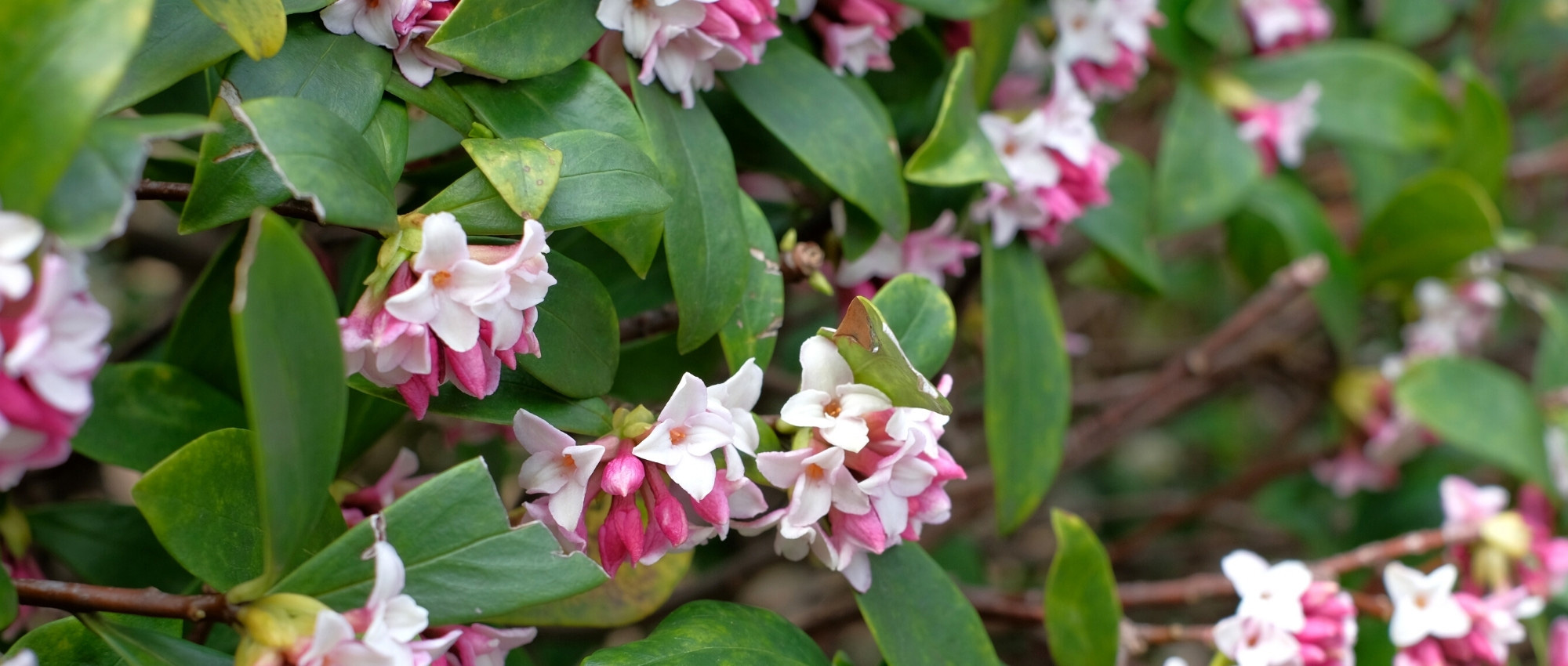
8 evergreen and fragrant shrubs
Discover our selection
Contents
Daphne, Choisya, Osmanthus or Mahonia: some bushes have the advantage of combining both evergreen foliage, ensuring a presence in the garden throughout the year, and pleasantly scented flowering. Their evergreen leaves are an asset for integrating them into a hedge, effectively concealing views even in winter, and their flowers will delight you with their delicate fragrances.
Feel free to combine them and plant them near the house or high-traffic areas to enjoy them to the fullest. Quickly discover our selection of the best evergreen and fragrant bushes, and if you want more options, do not hesitate to check our complete range by clicking here.
Daphne odora
Daphne odora is a charming shrub that offers a long flowering period in late winter (February-March), producing very fragrant pink flowers. It has beautiful elongated, dark green, glossy, thick leaves. This is a small-sized shrub that grows slowly, making it an ideal choice for small gardens. It does not exceed 1.50 m in height and spread. We particularly recommend the variety Daphne odora ‘Aureomarginata’, which features lovely dark green leaves highlighted by a delicate cream-yellow border! You can also choose the Daphne ‘Perfume Princess’, which also offers an intoxicating fragrance. It is even more compact, as it does not exceed 1.20 m in height and 90 cm in spread.
The Daphne thrives in shade or partial shade in humus-bearing, cool soil, but it must be well-drained, as it is sensitive to stagnant moisture. It prefers acidic pH soils. In the garden, pair it with Eranthis hyemalis, crocuses, daffodils, spring snowflakes, heathers…
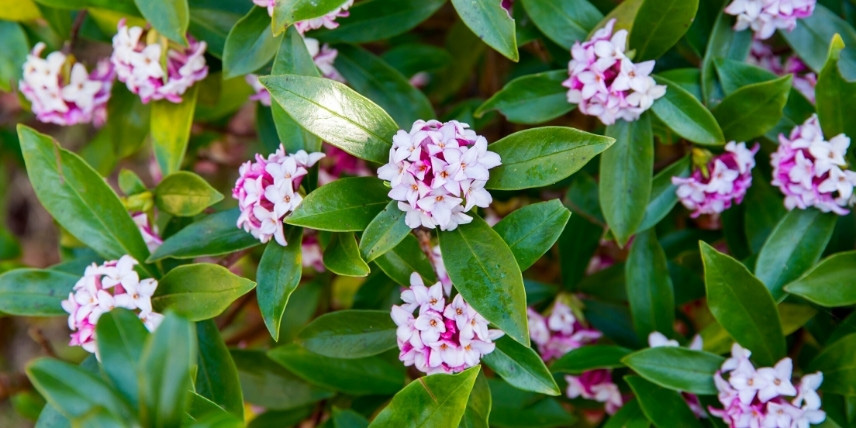
The Daphne odora produces beautiful small pink flowers gathered in bouquets
⇒ Discover our guide to learn all about growing Daphne
Choisya ternata
Mexican Orange Blossom, or Choisya ternata, is a beautiful shrub with palmate, finely cut leaves, and offers a stunning white flowering in April-May, whose fragrance resembles that of orange blossom… it actually belongs to the same botanical family, which gives it its nickname of Mexican Orange Blossom. Its leaves are also aromatic when crushed. We recommend the variety ‘Sundance’, which features beautiful golden foliage, ideal for brightening a shady spot, and also has the advantage of being repeat flowering, blooming again in early autumn (around September). You can also opt for ‘Aztec Pearl’, with very fine and graphic foliage.
The Choisya prefers rich, humus-bearing, well-drained soils, as its roots are sensitive to stagnant moisture. In the south of France, it is best planted in partial shade (otherwise its foliage may get scorched by the sun), while in the north, it will thrive in full sun. It can be planted in a seaside garden as it withstands sea spray. The Choisya is ideal in an exotic-style garden, alongside bamboos, Hakonechloa, Cannas, castor beans, daylilies, Musa basjoo…
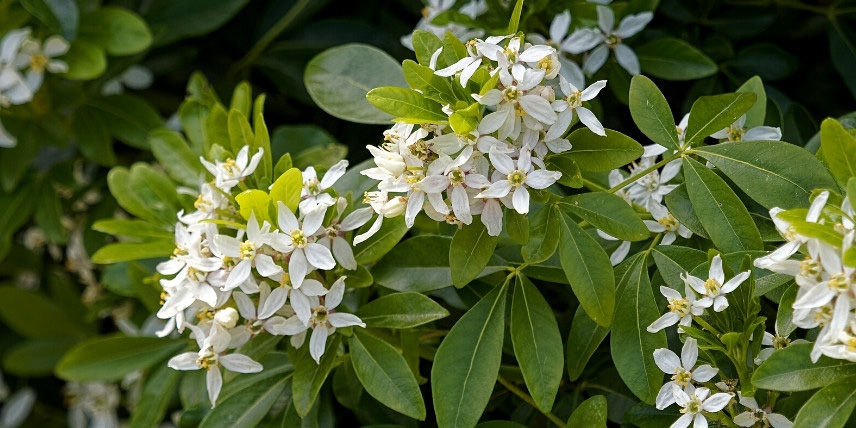
The white flowers of Choisya ternata, releasing a fragrance of orange blossom (photo Adobe Stock)
Discover other Evergreen shrubs
View all →Available in 0 sizes
Available in 1 sizes
Available in 1 sizes
Available in 1 sizes
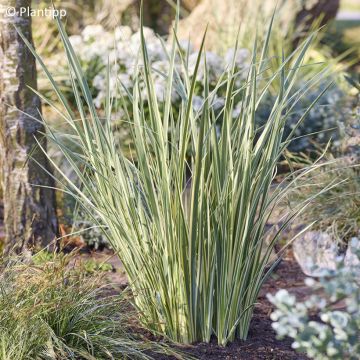
Available in 1 sizes
Available in 1 sizes
Available in 1 sizes
Available in 1 sizes
Available in 2 sizes
Available in 1 sizes
Sarcococca
Sarcococca is a charming little shrub that flowers in mid-winter, between January and March and bears small, delicate, highly fragrant white flowers. Its flowering is followed by small dark blue, black, or red berries, depending on the varieties. You might choose, for example, the Sarcococca confusa, which forms a small dense, rounded bush, not exceeding 1.5 m in all directions, or the Sarcococca hookeriana, which is even more compact (80 cm in height). Both offer a pronounced fragrance.
The Sarcococca has the advantage of being suited to dry shade. It thrives in cool, humus-bearing, neutral or acidic soil. It does not like lime. It is best to place it sheltered from cold winds, which could damage its flowering. It tolerates temperatures dropping occasionally to -15 °C. Take advantage of the Sarcococca to create a wild and natural shade border. You can associate it, for example, with camellias, azaleas, hellebores, Pachysandra, Rodgersia, Brunneras, and ferns…
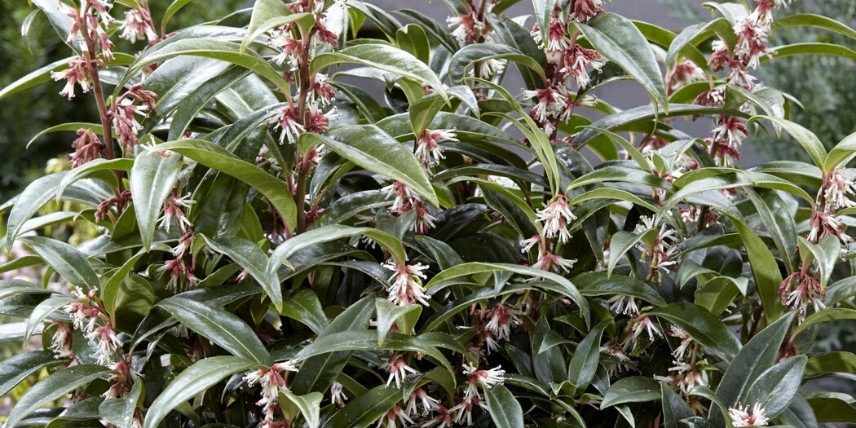
The delicate white flowers of Sarcococca ‘Winter Gem’
⇒ Feel free to check out our complete guide on the Sarcococca
Gardenia
Gardenia is among the most fragrant plants! This beautiful shrub offers elegant white flowers that can be single or double, depending on the variety. They release a pleasant fragrance reminiscent of jasmine. The Gardenia also features beautiful, thick, dark green, glossy leaves. It is a rather tender shrub; however, some varieties can withstand temperatures dropping down to -10 °C, even -12 °C: this is the case for example with ‘Summer Snow’, ‘Kleim’s Hardy’, and ‘Crown Jewel’.
It is still better to reserve its cultivation in open ground for mild climates. In cooler regions, you can plant it in a large container that you can bring indoors for the winter to protect it from the cold. Generally speaking, the Gardenia is a somewhat delicate shrub to grow: it needs cool but well-drained, rather fertile and acidic soil. It also appreciates humid atmospheres. In the garden, you can plant it alongside heather soil shrubs such as Pieris japonica, Kalmia, hydrangeas, rhododendrons, azaleas, camellias… As it offers beautiful white flowers, we recommend planting it with other white or white and pink blooms to create a romantic and elegant atmosphere.

The sumptuous, highly fragrant white flowering of Gardenia jasminoides
Osmanthus
Osmanthus flowers in spring or autumn (depending on the varieties) and produces small white flowers gathered in clusters. They release an intense fragrance reminiscent of jasmine or gardenia! The name Osmanthus comes from the Greek osmê (smell) and anthos (flower), meaning “fragrant flower.” You can choose the Osmanthus burkwoodii, which offers spring flowering, or Osmanthus heterophyllus, which blooms in autumn. The latter has spiny leaves resembling those of holly and is perfect for a defensive hedge. There are variegated varieties: for example, Osmanthus heterophyllus ‘Tricolor’ or ‘Variegatus’.
Osmanthus grows slowly and has a dense habit. Easy to grow, it is a hardy and low-maintenance shrub that adapts to all types of soil and thrives in both partial shade and full sun. You can use it to create an evergreen hedge or incorporate it into a romantic garden alongside roses, hardy geraniums, lady’s mantle, and lilacs. You can also take advantage of the spiny foliage of Osmanthus heterophyllus to form a defensive hedge alongside holly, pyracantha, and berberis.
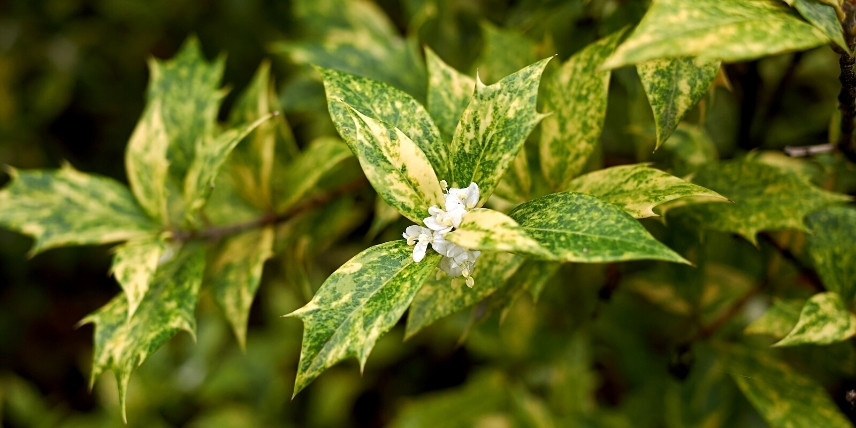
The Osmanthus heterophyllus ‘Tricolor’ offers small white flowers and very original variegated foliage
Elaeagnus ebbingei
Elaeagnus ebbingei, also known as Ebbing’s oleaster, offers a very discreet flowering, with small flowers hidden beneath the foliage, but has the advantage of being intensely fragrant. It blooms in autumn, between September and November, producing bell-shaped cream-white flowers. It has the advantage of forming a well-dense and ramified bush. There are many varieties, some with beautifully variegated yellow foliage, which prove valuable for bringing brightness and vitality to a border. It is an excellent evergreen bush for hedges.
Easy to grow, it is particularly resilient and adapts to all types of soil. It thrives in both sun and partial shade, is drought-resistant, tolerates salt spray, cold, and high heat, and is only sensitive to compact and waterlogged soils in winter. The Elaeagnus ebbingei grows quite quickly and benefits from regular pruning. In a hedge, for example, pair it with abelias, buddleias, photinias, Euonymus europaeus, Viburnum opulus, Ligustrum ovalifolium…

Ebbing’s oleaster, or Elaeagnus ebbingei, offers dense foliage that conceals a very discreet but pleasantly fragrant flowering (photo Adobe Stock)
⇒ Discover our guide to learn everything about Elaeagnus and succeed in its cultivation
Acacia dealbata
Wattle, or Acacia dealbata, is a large evergreen bush that produces a multitude of small yellow pompom flowers at the end of winter or the beginning of spring, releasing a pleasant honey fragrance. Its finely dissected foliage, reminiscent of fern leaves, is also appreciated. However, it is best suited for regions with a very mild climate, as it cannot withstand temperatures below -6 °C. An alternative is to grow it in a large pot that can be sheltered for the winter. You may also consider Acacia retinodes, also known as the Four Seasons Mimosa, which flowers multiple times a year and is also highly fragrant.
The Acacia thrives in full sun, in well-drained soil, and in a location sheltered from cold winds. It is very resistant to summer drought. In the garden, feel free to pair the Acacia with other exotic-style shrubs: for example, callistemon, Caesalpinia gilliesii, Sesbania punicea, grevilleas, Aloe striatula… You will easily create a captivating atmosphere that invites travel!
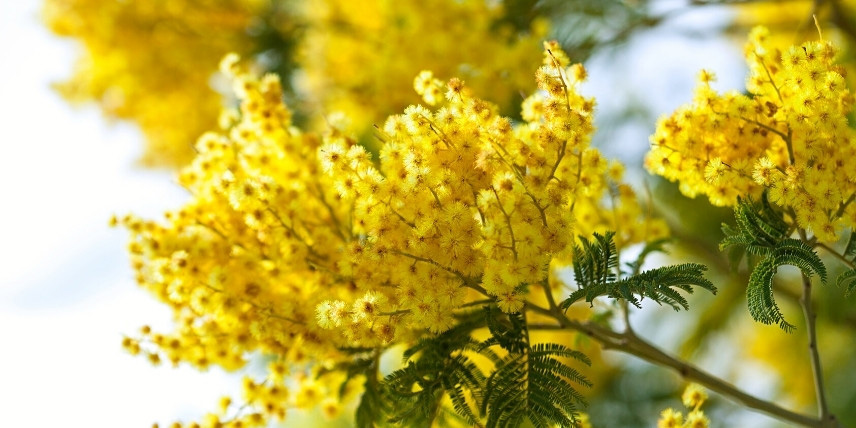
The stunning yellow pompom flowering of Mimosa, or Acacia dealbata (photo Adobe Stock)
Mahonia
Mahonia is valued for its glossy dark green evergreen foliage, resembling holly leaves, and its bright yellow flowering, which is very vibrant and pleasantly scented. The flowers release a lily of the valley fragrance. It typically blooms in winter (sometimes in autumn or early spring, depending on the varieties). We recommend the variety Mahonia x media ‘Charity’, which produces beautiful upright clusters of small yellow flowers in mid-winter.
Mahonia thrives in shaded conditions, for example, under the canopy of deciduous trees, in humus-bearing, well-drained, and porous soil that is not too compact. Pair it with other shrubs that bloom at the same time, such as Chimonanthus praecox, Daphne odora (which also offers a pleasant fragrance), as well as Eranthis hyemalis, Oriental hellebores, witch hazel, snowdrops… This will create a stunning winter scene!
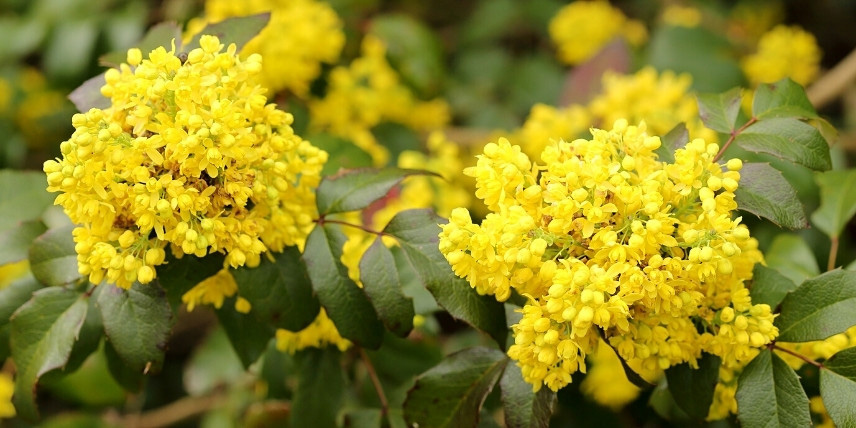
The vibrant flowering of Mahonia aquifolium
⇒ Discover all our tips on growing Mahonia
- Subscribe!
- Contents
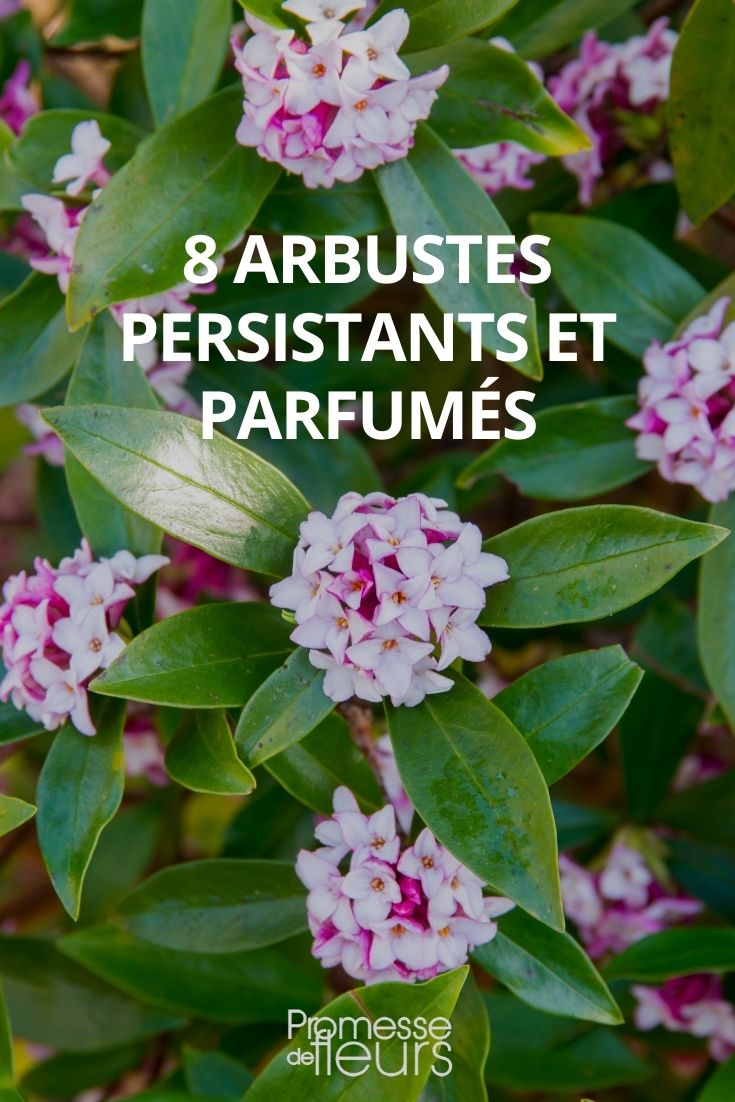
































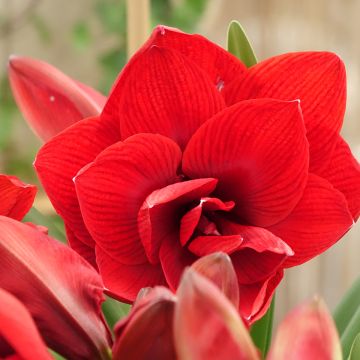


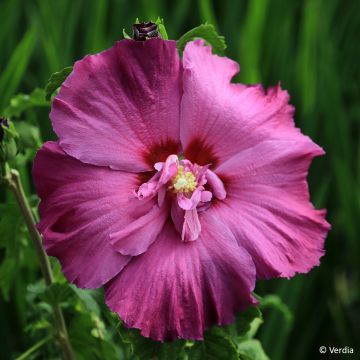

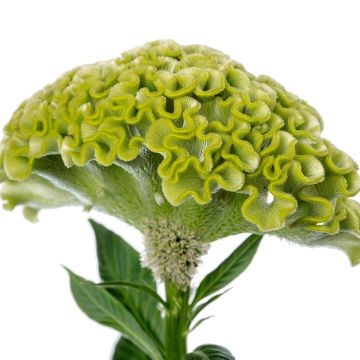
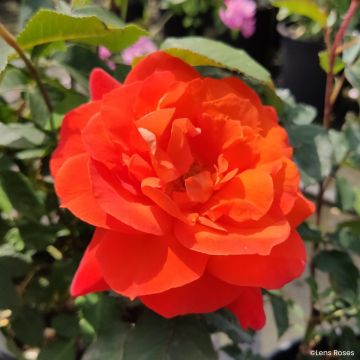

Comments